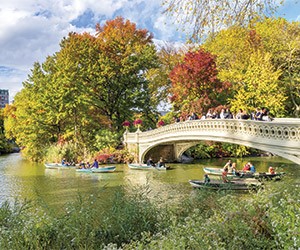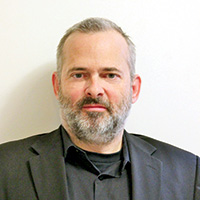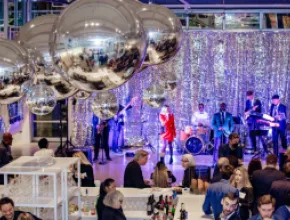Frederick Law Olmsted Sr. (1822-1903), the father of American landscape architecture, enjoys a singular artistic legacy– each day, more people surely experience his works than those of any other American artist in any medium in any time.
Spanning the nation, his 500-plus lifetime commissions and other engagements include the scenic preservation of giant sequoias in California’s Yosemite Valley; design of the U.S. Capitol grounds and terraces in Washington, D.C.; and his swan song, the 120,000-acre Biltmore Estate near Asheville, N.C.
Then there’s New York, the seat of Connecticut-born Olmsted’s outdoor empire.
In 1858, Olmsted and London-born architect Calvert Vaux won a state-appointed competition to transform 750-plus acres in Manhattan into America’s first major landscaped public park.
Expanded to 843 acres and completed in 1873, Central Park today is America’s most-frequented urban park, attracting some 42 million visitors annually.
Influential in his own right, Vaux parted ways with Olmsted in 1872 (they briefly reunited later), while Olmsted continued shaping the American landscape from coast to coast. With 6,000-plus total projects in his name via successor firms lasting until 1979, his total impact is hard to calculate, but easy to comprehend.
Many other talented artists, as well as nature itself, have contributed to New York’s diverse collection of designed and curated outdoor spaces. From botanical gardens and sculpture parks to glacier-carved cascades, here are some pleasing paths to a happy New York state of mind.
Bountiful Botanica
Created in ancient times for studying medicinal plants and herbs, and later, for pure pleasure, botanical gardens offer effortless inspiration and rewards for tours, events and educational programs. New York has at least 30 statewide, including several group-capable gems in the New York City area.
Inspired by London’s UNESCO-listed Royal Botanic Gardens, Kew, the national landmark New York Botanical Garden, opened in 1891, is a global leader in plant research, conservation and education.
Laid out by Vaux with later development by Olmsted’s firm, this 250-acre Bronx treasure includes 50 acres of old-growth forest. Versatile spaces include the rustic, newly refurbished Stone Mill and 1,000-capacity Victorian-style Enid A. Haupt Conservatory, comprising 11 interconnected glasshouse galleries around two elegant pools. Wave Hill, also in The Bronx, is an 1843 clifftop estate overlooking the Hudson River with lovely gardens.
Opened in 1911, the exquisite Brooklyn Botanic Garden (original site work by Olmsted’s firm) comprises 15 gardens, five conservatories and more on 52 acres. Hosting events for 130 people, the LEED Gold–certified Steinberg Visitor Center features geothermal heating and a living roof planted with native grasses and wildflowers. Groups of 275 can also gather at the Victorian-era Palm House.
The gardens sit between the event-capable Brooklyn Museum and another Olmsted-Vaux national landmark, Prospect Park, celebrating its 150th anniversary this year. Attracting some 10 million annual visitors, “Brooklyn’s Backyard” hosts events in its 1905 Beaux Arts Boathouse and historic Picnic House, overlooking 90-acre Long Meadow.
Staten Island, the “Borough of Parks,” is home to the national landmark Snug Harbor Cultural Center & Botanical Garden. Set on an 83-acre campus created in 1833 as a haven for retired sailors, the gardens, opened in 1977, include the Ming Dynasty-inspired New York Chinese Scholar’s Garden, one of only two in the nation, and Tuscan Garden, both available for events.
At the Queens Botanical Garden, groups meeting at the LEED Platinum-certified Visitor & Administration Building also have 39 acres of lush landscapes and specialty gardens for break-out sessions and teambuilding activities.
Westchester County’s collection of Gilded-Age estates includes event-capable Lyndhurst (1838). Considered a paragon of Gothic Revival architecture, the tour-capable mansion is set on 67 acres overlooking the Hudson River. Landscaping highlights include the event-capable Great Lawn; framework of the nation’s first steel-framed conservatory; Rose Garden; and weeping beeches—step inside for a cathedral-like communion with nature.
Long Island’s heirlooms include the former Coe Estate, now Planting Fields Arboretum State Historic Park. Featuring a historic mansion and conference-capable venues, this 409-acre escape’s horticultural charms include magnificent greenhouses and a new Sensory Garden.
Bloom Towns
Surrounded by 40,000 acres of protected, pristine forest, the fairytale Mohonk Mountain House, with 85-plus miles of hiking trails and unique features like the Labyrinth rock scramble and its legendary Lemon Squeeze vertical ladder climb, offers outdoor pursuits on a grand scale.
True to its 1869 founding as a place of peaceful retreat, this 600-room National Historic Landmark Victorian castle-resort in New Paltz, N.Y., some 90 miles north of NYC, also presents more intimate connections with nature, such as tours of its Victorian Show Garden. Led by the property’s master gardeners and horticulturists, this guided experience reveals the greenhouses and gardens, where each year, more than 300 flower and plant species are incorporated in a themed showcase.
PageBreakThe horticultural heritage continues in Dutchess County, some 90 miles north of NYC. Highlights include magical Innisfree and its Chinese-inspired “cup gardens” in Millbrook; the time capsule Italian, pool and rose gardens at the Vanderbilt Mansion National Historic Site in Hyde Park; and the landscaped grounds surrounding spellbinding Olana, the 1891 Vaux-designed hilltop home of Hudson River School painter Frederick Church.
For Albany, the March 2017 debut of the Albany Capital Center, more than two decades in the making, ushered in a fertile new era of conventions and meetings for the state capital. With 127 events contracted from March 1, 2017 to Dec. 31, 2017, the $78 million, 82,000-square-foot facility united with the Empire State Plaza Convention Center, The Egg Performing Arts Center, and the Times Union Center Arena to form The Capital Complex. At more than 159,000 square feet of flexible space, it became the largest meeting facility in Upstate New York.
With this fruitful future-forward step, Albany remains a destination with unique heritage appeal. For groups visiting in June, the Historic Albany Foundation offers its annual Hidden City House & Garden Tour. With the 43rd edition ahead in June 2018, this guided tour showcases historic buildings and their gardens, highlighting premiere Albany architecture and ongoing preservation efforts. Planners can also arrange customized tours, with options to include, for example, local master gardeners and outdoor sculpture artists.
Capital Region groups can experience the rare Albany Pine Bush Preserve. One of only 20 remaining inland pine barrens in the world, this 3,200-acre National Natural Landmark includes 18 miles of recreational trails and the LEED Gold-certified Discovery Center.
Saratoga groups can book a historic hotel inside a national landmark park. Located within the 2,300-acre Saratoga Spa State Park, the 124-room Gideon Putnam resort offers 12,000-plus square feet of indoor and outdoor space, including the newly renovated ballroom. Groups can also tour Saratoga’s popular free-admission Yaddo Gardens, an experimental creation from 1899 featuring terraced rose and woodland rock gardens.
In 1868, it was the Buffalo Parks Commission’s turn to seek out Olmsted. Partnering with Vaux, his ground-breaking integration of parks, parkways and landscaped circles earned Buffalo global acclaim and became a national model for comparable future designs.
Managed by the Buffalo Olmsted Parks Conservancy, the 850-acre system offers multiple rental facilities and attracts over 1 million annual visitors. In South Park, Olmsted co-designed the 1900 Buffalo and Erie County Botanical Gardens. Inspired by London’s legendary Crystal Palace, this national historic site attracts over 100,000 people annually. Rental spaces include the connecting Victorian greenhouses or full venue buyouts.
Olmsted was also instrumental in the scenic preservation of the nearby Niagara Reservation.
An hour east of Buffalo, Rochester, the “Flower City,” also has deep Olmsted roots. Hired by its Parks Commission in 1888, Olmsted found harmony for his “pastoral landscape” vision in
Rochester’s gorges and waterways. His resulting “emerald necklace” includes Highland Park, site of Rochester’s annual welcome to spring, the Lilac Festival.
Rochester groups can also enjoy the event-capable formal gardens at Kodak founder George Eastman’s former urban estate, part of the George Eastman Museum. Picture-worthy, too, is Sonnenberg Gardens and Mansion State Historic Park in nearby Canandaigua, featuring rare surviving Lord & Burnham (Olmsted’s co-collaborators in Buffalo) greenhouses built between 1903 and 1915.
At Ithaca’s serene Cornell Botanic Gardens, event spaces include the LEED Gold-certified Brian C. Nevin Welcome Center and F. R. Newman Arboretum.
Art in Nature
Inside a museum, architecture, design and art collaborate—or conspire—to inspire or provoke distinct reactions. Move art outside, and the engagement changes completely. For groups seeking creative inspiration, New York’s en plein air sculpture gardens and parks can shift the agenda in unexpected and exciting ways.
Reopened this spring, the Donald M. Kendall Sculpture Gardens at PepsiCo’s world headquarters in Purchase, N.Y., offer a blue-chip agenda booster for Westchester County groups (especially those convening minutes away at IACC-certified, Benchmark-managed Doral Arrowwood Hotel Conference Center).
Conceived by PepsiCo’s former namesake chairman of the board and CEO, the collection, started in 1965, features 46 works by major 20th century artists on exquisitely landscaped gardens and grounds. The campus is open for free self-guided weekend visits from April to October.
An hour north of NYC in the lower Hudson River Valley, Storm King Art Center features 100-plus large-scale outdoor art installations from the 1950s onward. Founded in 1960, the 500-acre campus’ five distinct zones include Museum Hill and the expansive South Fields, both available for outdoor and tented events. Groups can arrange docent-led tours, rent bicycles, or ramble fields, hills and woodlands to discover works such as Three-Legged Buddha, the gravity-defying Suspended steel sculpture, and through Nov. 12, David Smith: The White Sculptures, honoring the 50th anniversary of 13 Smith works acquired in 1967.
In 1938, Pittsburgh-born sculptor Harvey Fite purchased an abandoned quarry in Saugerties, N.Y. Over the next 37 years, he single-handedly cut and crafted local bluestone into Opus 40, a six-plus acre labyrinth of curving ramps, terraces, passageways and moats, crowned by a nine-ton bluestone monolith. In 1976, an on-site accident took his life, but his singular achievement endures. Backed by Overlook Mountain and the Catskill Range, the site, which includes Fite’s Quarryman’s Museum, is an area must for tours and events.
Featuring 80 works on 300 acres of farmland, The Fields Sculpture Park at the Omi International Arts Center in Ghent (Hudson Valley/Catskills region) is another exquisite choice for tours and events.
In Cooperstown, art, nature and hospitality converge at two near-adjacent properties on glimmering Otsego Lake. Offering 132 freshly renovated guest rooms and 30,000 square feet of flexible space, the grand Otesaga Resort Hotel, from 1909, is located nearby the Fenimore Art Museum, where event space includes elegant terraced English garden areas with gazebos.
Adirondacks groups based at the Mirror Lake Resort in Lake Placid can let their imagination soar at the 81-acre, natural history-focused Wild Center, New York’s first LEED-certified museum. Located 30 miles west in Tupper Lake, the venue’s 40-foot- high Wild Walk trail invites interactive play in the four-story twig tree house, swinging bridges, and giant spider’s web and bald eagle’s nest.







